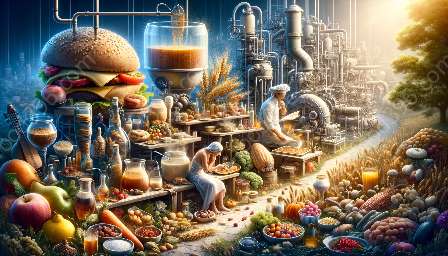Food packaging and labeling have significantly evolved over time, driven by technological advancements and the changing food culture and history. In this comprehensive guide, we'll explore the impact of these advances on food technology and innovation, as well as their influence on food culture and history.
The Evolution of Food Packaging Innovations
Food packaging has come a long way from simple containers and wrappings to sophisticated and innovative packaging solutions. With the advancement in materials, manufacturing processes, and consumer demands, food packaging has witnessed significant evolution.
Technological Advancements in Packaging Materials
The development of advanced packaging materials, such as biodegradable plastics, active packaging, and intelligent packaging, has revolutionized the way food is preserved, stored, and transported. These materials not only extend food shelf life but also ensure food safety and quality.
Smart Packaging Technologies
Smart packaging technologies, including sensors and RFID tags, have enabled real-time monitoring of food products during storage and transportation. These innovative solutions help in detecting spoilage, ensuring traceability, and maintaining the integrity of the food supply chain.
Sustainable Packaging Solutions
With the growing awareness of environmental sustainability, food packaging has seen a shift towards eco-friendly and sustainable solutions. From biodegradable packaging to compostable materials, the focus is on reducing the environmental impact of packaging and promoting a circular economy.
Impact on Food Technology and Innovation
The advances in food packaging have significantly influenced food technology and innovation, leading to improved food preservation, safety, and convenience.
Extended Shelf Life
The use of advanced packaging techniques, such as modified atmosphere packaging and vacuum packaging, has extended the shelf life of food products, reducing food waste and ensuring a longer window for consumption.
Convenience and Portability
Modern food packaging designs prioritize convenience and portability, making it easier for consumers to access and consume food on the go. Single-serve packaging, resealable pouches, and portion-controlled packaging are examples of such innovations.
Enhanced Food Safety
Advanced packaging technologies play a crucial role in maintaining food safety and quality. From barrier packaging to antimicrobial coatings, these innovations help in preventing contamination and preserving the nutritional value of food.
Influence on Food Culture and History
The evolution of food packaging and labeling has had a profound impact on food culture and history, shaping consumer behaviors, dietary preferences, and the overall food industry.
Consumer Perception and Branding
Attractive and informative packaging designs have the power to influence consumer perception and purchasing decisions. The visual appeal and storytelling elements of packaging contribute to the cultural significance of food products.
Globalization and Food Accessibility
Advances in food packaging have facilitated the global distribution of food products, introducing consumers to a wide variety of cuisines and flavors from different parts of the world. This has contributed to the diversification of food culture and culinary traditions.
Cultural Preservation and Traditions
Traditional food packaging methods and designs play a significant role in preserving cultural heritage and food traditions. In some cases, modern packaging solutions have been adapted to align with traditional values and practices.
Conclusion
The continuous advancements in food packaging and labeling have not only revolutionized the way food is preserved, transported, and consumed but have also left a lasting impact on food technology, innovation, and cultural aspects. As technology continues to progress, we can expect further innovations that will shape the future of food packaging and its relationship with food culture and history.

